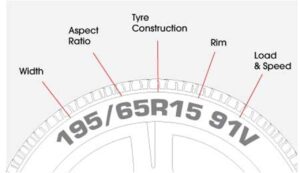When it comes to ensuring your vehicle’s safety, performance, and overall driving experience, selecting the right tires is paramount. The seemingly simple decision of choosing tires can significantly impact your car’s handling, fuel efficiency, and even your comfort on the road. In this comprehensive guide, we’ll walk you through the essential factors to consider when choosing the perfect tires for your car. Whether you’re a seasoned car enthusiast or a casual driver, this guide will equip you with the knowledge needed to make an informed decision.
Understanding Tire Basics:
Before diving into the details of tire selection, it’s important to understand some key tire basics. Tires are more than just round rubber objects; they are a complex combination of materials, patterns, and technologies designed to optimize your vehicle’s performance. Tires are labeled with a series of numbers and letters, such as “P215/60R16.” Let’s break down what these numbers mean:
- P215: This indicates the tire width in millimeters. In this case, the tire is 215 millimeters wide.
- 60: This is the aspect ratio, representing the tire’s height as a percentage of its width. For this tire, the height is 60% of its width.
- R16: “R” signifies radial construction, which is the most common type. “16” represents the diameter of the wheel in inches that the tire fits.

Consider Your Driving Needs:
One size does not fit all when it comes to tires. Your driving habits and the conditions you typically encounter will play a significant role in your tire selection. Consider the following factors:
- Weather Conditions: If you frequently drive in snowy or icy conditions, winter tires with special tread patterns and rubber compounds provide better traction. All-season tires are a good compromise for varying weather conditions.
- Driving Style: Are you a spirited driver who enjoys taking corners with gusto, or do you prioritize a comfortable, smooth ride? High-performance tires offer better grip and handling, while touring tires prioritize comfort.
- Terrain: If you often venture off-road or encounter rough terrains, consider all-terrain tires for their durability and off-road capabilities.
Tire Types:
Tires come in various types, each tailored to specific driving needs:
- Summer Tires: Designed for optimal performance in dry and wet conditions. They provide superior grip and handling but may struggle in colder temperatures.
- All-Season Tires: Versatile tires suitable for most conditions, offering a balance between performance and longevity.
- Winter Tires: Specially designed for cold weather, snow, and ice. They feature unique tread patterns and rubber compounds that remain pliable in low temperatures.
- Performance Tires: Geared towards enhancing your vehicle’s handling and grip. These are often used in sports cars and enthusiast vehicles.
- Touring Tires: Prioritize comfort and low road noise, making them ideal for long highway drives.
Tire Load Capacity and Speed Rating:
It’s essential to choose tires that match your vehicle’s load-carrying capacity and speed capabilities. This information is indicated by codes on the tire sidewall. For instance, a “92H” code means the tire can carry 1,389 pounds and is rated for speeds up to 130 mph. Match these ratings to your car’s specifications for safety and optimal performance.
Tread Patterns:
Tread patterns play a crucial role in a tire’s performance. Different patterns are designed for specific driving conditions:
- Symmetrical Tread: Offers a quiet and smooth ride. Suitable for standard driving conditions.
- Asymmetrical Tread: Combines various tread patterns for improved grip, handling, and water dispersion.
- Directional Tread: Features V-shaped grooves that channel water away for enhanced wet-weather performance.
- Mud and Snow (M+S) Tread: Aggressive tread pattern for off-road and winter conditions.
Tire Maintenance and Longevity:
Once you’ve chosen the right tires, proper maintenance is crucial to ensure their longevity and performance:
- Regular Inspections: Check your tires for signs of wear, cuts, bulges, or punctures. Uneven tread wear may indicate alignment or suspension issues.
- Proper Inflation: Keep your tires inflated to the manufacturer’s recommended pressure. Underinflation can reduce fuel efficiency and tire lifespan.
- Rotation: Regularly rotate your tires to ensure even wear. Refer to your vehicle’s manual for recommended intervals.
- Alignment: Proper wheel alignment prevents uneven wear and ensures optimal handling.
Budget Considerations:
Tire prices can vary widely based on type, brand, and size. While it’s tempting to choose the cheapest option, remember that tires are a long-term investment in your safety and driving experience. Consider the overall value and performance of the tires within your budget.
Consult the Experts:
If you’re unsure about which tires are best for your car, consult with knowledgeable professionals. Tire specialists can provide valuable insights based on your driving habits, vehicle type, and local weather conditions.
In conclusion, choosing the right tires for your car is a critical decision that directly affects your safety and driving experience. By considering your driving needs, understanding tire types, load capacities, tread patterns, and maintenance requirements, you can make an informed choice that enhances your vehicle’s performance and your overall driving satisfaction. Remember, the right tires aren’t just about rubber and tread – they’re about optimizing every mile you drive.
With this comprehensive guide at your fingertips, you’re equipped to make a tire decision that aligns with your driving preferences and ensures a smooth, safe, and enjoyable journey on the road.



